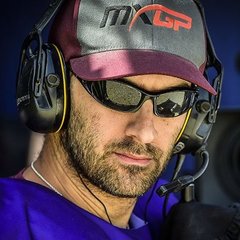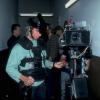-
Posts
42 -
Joined
-
Last visited
Reputation
1 NeutralAbout Michael Tsimperopoulos SOC

Profile Information
-
Location
Greece
-
Rig
Complete system
Recent Profile Visitors
-
IMHO, with the exception of the occasional specialty shot, uncoupling the framing from the camera move and delegating these functions to two different people is a major step backwards. Granted, grips and operators have been coordinating to execute complex camera moves since forever, but perhaps there is something to be said about the benefit of having to deal with the added mass of a dolly, a crane, or a jib-arm when attempting to feather a move to a start or a stop as opposed to a steadicam, an easyrig or a hanheld camera. Perhaps that Movi joystick will find its way on the yoke, or someone will be able to interface the sled’s position in relation to the Movi head in a way that the head will ignore our panning and tilting of the post. Let’s see how things develop… Mounting a gyro-stabilized head on a steadicam sled is not a new idea, and most of us have seen such attempts. As it was mentioned in another thread, one of the closest permutations, was that Rollvision head, back in 2001. That was also a two-man operation. That 3-axis stabilized head indeed created a buzz for a little while, but the amount of communication and coordination that it required in order for two crew members to execute any predetermined shot with any kind of accuracy, was a clusterfuck of epic proportions. According to the company that produced it, Garrett himself was involved, offering advice on how to streamline the device even further and make it more steadicam-friendly. But it was not worth the headache. The concept never took off, not even for that rare specialty shot.
-
-

Steadicam for POV perspective pointing down
Michael Tsimperopoulos SOC replied to Frank Schwaiger's topic in Operating
-

Steadicam for POV perspective pointing down
Michael Tsimperopoulos SOC replied to Frank Schwaiger's topic in Operating
In the car: handheld Restaurant: handheld Running up the stairs: steadicam Roof: steadicam Jump: helmet-cam -

Steadicam for POV perspective pointing down
Michael Tsimperopoulos SOC replied to Frank Schwaiger's topic in Operating
Regarding “T2”, Jimmy indeed used the Lightstorm HID, with an Arri 35-3 on his 3A, for those running-down-the-stairs shots. The SL was not yet available at that time. -

Steadicam for POV perspective pointing down
Michael Tsimperopoulos SOC replied to Frank Schwaiger's topic in Operating
Regarding “Strange Days”, Afton’s description on SteadiShots is correct. The Ken Robings SL (35mm) camera was used, either hand-holding it and monitoring the shot via a Lightstorm Technologies HID (Helmet Integrated Display), or on a Cinema Products SK prototype. Only the last shot of the sequence is accomplished with a helmet-mounted 35mm Eyemo. On a side note, the footage was then transferred to standard definition D-1 format, where they “stitched” the shots and created the “digital tearing and artifacts”. I always thought that it was such a shame to get into all that trouble to shoot 35mm in order to end-up with an NTSC image on the screen… -

Interesting new rig
Michael Tsimperopoulos SOC replied to Charles Papert's topic in General Discussion
-

Mounting Phantom on it's side on sled ?!
Michael Tsimperopoulos SOC replied to Mako Koiwai's topic in Cameras (Film/Video/HD)
A few years ago, I was asked to fly a Varicam on its side, for a video-instalation art project where all monitors would also be sitting on their sides. It was a spur of the moment kind of thing, so a little improvisation was required as the sun was going down. I used a Hill Arri-3 Low-Mode Bracket to mount the camera on its side, and quite a few dogbones attached to the XCS plate to provide the much-needed rigidness and support. Surprisingly, there was no vibration whatsoever. The Transvideo Cinemonitor has mounting points on all sides, so that was easy. If I had a little more time, I'm sure I would find a more elegant way to do it, but most probably the Hill bracket would be my starting point once again. On a side note, the experience of composing for a vertical frame (9:16) was so refreshingly different, that I had a wonderful time. Take care ! -

New Fawcett/Tiffen exoskeleton vest
Michael Tsimperopoulos SOC replied to Fabrizio Sciarra SOC ACO's topic in Vests
-
I agree with Janice and Eric. I carry one of those systems with me, but it gets to see action less than once every year, and even if that. Once in a while I’m faced with one of those flat-out running shots preceding the talent, where it is too narrow for a quad, a rickshaw or a handsfree, or there may be steps involved, uneven terrain or very tight turns, and I can’t afford to even turn my head and glimpse at the monitor. The headset allows me to keep one eye on the ground and the other on an image, to have at least an idea of where my subject is and its headroom. Left-right is the same, tilt is in reverse, level is with the Force. It takes lots of practice and an even more Dramamine afterwards, but I had very satisfactory results with this approach and –admittedly- no real alternative. Sometimes, turning the sled’s base 180 degrees so I can face the monitor seems to do the trick, but it totally depends on the occasion.
-
Then again...who needs glasses ? :blink:
-

STEADICAM in Blade Runner?
Michael Tsimperopoulos SOC replied to Douglas John Kropla's topic in Operating
Nope.

































